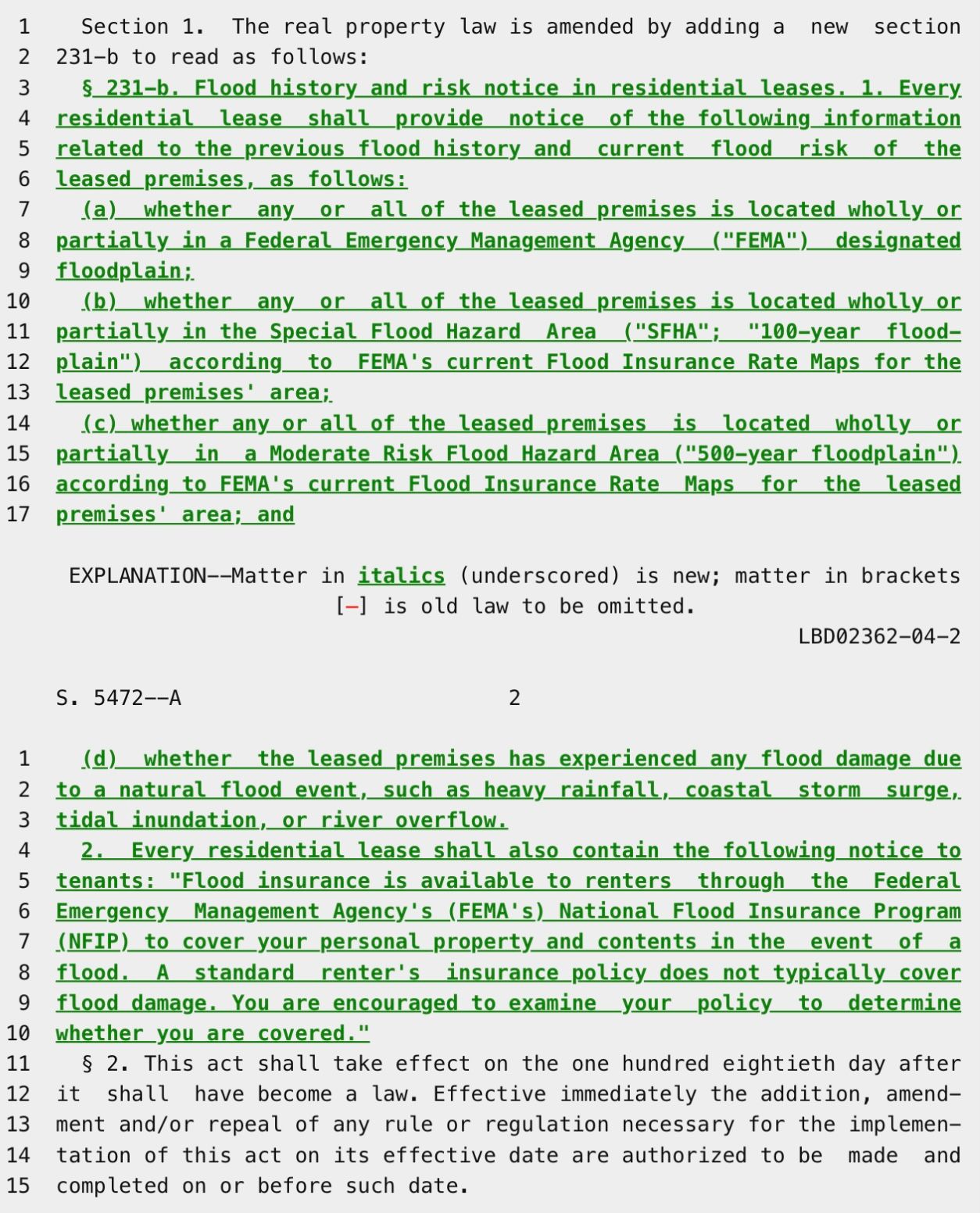On December 23, 2022, Gov. Hochul signed A07876-A/S05472-A into law, requiring every residential lease in New York to have a flood disclosure and to provide notice of information concerning flood insurance. This law became effective on June 21, 2023.
The legislation adds a new section the Real Property Law, section 231-b:

The memo to the legislation provides the following justification for the law:
This bill would establish a flood risk "right to know" for renters. The Natural Resources Defense Council (NRDC) currently gives New York's flood risk disclosure law a failing grade in part because New York's flood disclosure laws only apply to sales of residential real property, meaning that renters are not receiving adequate disclosures about the flood risks and history of the units they lease.
Recent storms, like Hurricanes Ida and Henri, caused damage to thousands of apartments and extensive damage to the personal property of rental households. Robust flood disclosure is a necessary tool for protecting New Yorkers on the frontline of climate change. Vulnerable communities have repeatedly expressed concerns regarding the growing costs of flood damage in their homes, but renters from low-income communities experiencing repeated flood events are often never warned about the risks they face when moving into a new home. Flood disclosure meets the fundamental goal of providing awareness and transparency for all residents, irrespective of income. Studies have shown that knowing the level of one's risk helps change patterns of behavior related to flood insurance, increasing uptake of up to 15 percent or more.
This legislation was considered a partial win by supporters. See Ari Ephraim Feldman, State bill would require flood risk disclosure for rentals, but not sales, ny1.com, May 26, 2022. They recently completed their victory by enacting disclosure requirements for sales. See Hani Sarji, Three Recent Changes to New York's Property Condition Disclosure Statement, Wills, Trusts, Estates, Sept. 28, 2023.
My reading of RPL 231-b is that subsections (1)(a), (1)(b), and (1)(c) pertain only to FEMA maps. So, even though Feldman points out that NYC is releasing its own maps, the law requires landlords to examine only FEMA data.
Also, subsections (1)(b) and (1)(c) pertain only "to FEMA's current Flood Insurance Rate Maps." Feldman points out that FEMA's maps will be updated in 2024. But if the current FEMA maps are from 2015, then that is the data that landlords have to work with.
Finally, subsection (1)(d) is problematic for landlords:
- It doesn't limit the history for the disclosure, which suggests that a landlord might have to disclose "damage" before the landlord purchased the property.
- It doesn't state that the disclosure can be based on a landlord's actual knowledge, which suggests that a landlord might have a duty to investigate.
The disclosure requirement in subsection (1)(d) might make more sense once sellers start disclosing flood risk information on the Property Condition Disclosure Statement (PCDS). Sellers will be required to give a PCDS starting March 20, 2024, and starting that date, the PCDS will be expanded to include several flood disclosure questions. Right now, I don't know how a landlord can meet the disclosure requirement under subsection (1)(d) without limiting the disclosure to the landlord's actual knowledge, which usually corresponds with the landlord's ownership of the property.
(Update 11/11/2023: I updated this blog post by adding the paragraphs that examine subsections (1)(a) - (d). I am very grateful to fellow New York lawyers on the New York State Bar Association Real Property Law Section's listserv. Some insight stems from my colleagues, but all errors are mine.)
(Update 5/13/2024: Homes and Community Renewal promulgated a sample "Flood History and Risk Lease Rider/Notice to Residential Tenants" here and here.)
Hani Sarji
New York lawyer who cares about people, is fascinated by technology, and is writing his next book, Estate of Confusion: New York.






Leave a Comment